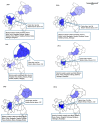Epidemiological Characteristics and Spatial-Temporal Distribution of Hand, Foot, and Mouth Disease in Chongqing, China, 2009-2016
- PMID: 29401726
- PMCID: PMC5858339
- DOI: 10.3390/ijerph15020270
Epidemiological Characteristics and Spatial-Temporal Distribution of Hand, Foot, and Mouth Disease in Chongqing, China, 2009-2016
Abstract
(1) Objective: Even with licensed vaccine for enterovirus 71 (EV71) put into market in 2016 in China, hand, foot, and mouth disease (HFMD) is still a threat for children's health in Chongqing. We described the epidemiological characteristics and spatial-temporal patterns of HFMD in Chongqing from 2009 to 2016, in order to provide information and evidence for guiding public health response and intervention. (2) Methods: We retrieved the HFMD surveillance data from January 2009 to December 2016 from "National Disease Reporting Information System", and then analyzed demographic and geographical information integrally. Descriptive analysis was conducted to evaluate the epidemic features of HFMD in Chongqing. The spatial-temporal methods were performed to explore the clusters at district/county level. (3) Results: A total of 276,207 HFMD cases were reported during the study period (total population incidence: 114.8 per 100,000 per year), including 641 severe cases (129 deaths). The annual incidence of HFMD sharply increased in even-numbered years, but remained stable or decreased in odd-numbered years. A semiannual seasonality was observed during April to July, and October to December in each year. The male-to-female ratios of the mild and severe cases were 1.4:1 and 1.5:1, with the median age of 2.3 years and 1.9 years, respectively. More than 90% of the cases were children equal to and less than 5 years old. High-incidence clustered regions included the main urban districts and northeast regions according to incidence rates comparison or space-time cluster analysis. A total of 19,482 specimen were collected from the reported cases and 13,277 (68.2%) were positive for enterovirus. EV71 was the major causative agent for severe cases, while other enteroviruses were the predominant serotype for mild cases. (4) Conclusions: The characteristics of HFMD in Chongqing exhibited a phenomenon of increasing incidence in two-year cycles and semiannual seasonality in time distribution. Children ≤5 years old, especially boys, were more affected by HFMD. EV71 was the major causative agent for severe cases. We suggest initiating mass EV71 vaccination campaigns among children aged 6 months to 5 years in Chongqing, especially in the main urban districts and northern regions, in order to reduce case fatality, and take integrated measurements for controlling and preventing HFMD attributed to other enteroviruses.
Keywords: epidemiology; hand, foot, and mouth disease; seasonality; surveillance.
Conflict of interest statement
The authors declare no conflict of interest. The founding sponsors had no role in the design of the study, in the collection, analyses, or interpretation of the data, in writing the manuscript; or in making the decision to publish the results.
Figures






Similar articles
-
Epidemiological Characteristics and Spatial-Temporal Clusters of Hand, Foot, and Mouth Disease in Zhejiang Province, China, 2008-2012.PLoS One. 2015 Sep 30;10(9):e0139109. doi: 10.1371/journal.pone.0139109. eCollection 2015. PLoS One. 2015. PMID: 26422015 Free PMC article.
-
The surveillance of the epidemiological and serotype characteristics of hand, foot, mouth disease in Neijiang city, China, 2010-2017: A retrospective study.PLoS One. 2019 Jun 6;14(6):e0217474. doi: 10.1371/journal.pone.0217474. eCollection 2019. PLoS One. 2019. PMID: 31170178 Free PMC article. Clinical Trial.
-
Epidemiological and clinical characteristics of severe hand-foot-and-mouth disease (HFMD) among children: a 6-year population-based study.BMC Public Health. 2020 May 27;20(1):801. doi: 10.1186/s12889-020-08961-6. BMC Public Health. 2020. PMID: 32460823 Free PMC article.
-
[Review on the etiology and complications of hand, foot and mouth disease, using data from the national sentinel surveillance program, in China, 2015-2016].Zhonghua Liu Xing Bing Xue Za Zhi. 2019 Jun 10;40(6):627-632. doi: 10.3760/cma.j.issn.0254-6450.2019.06.005. Zhonghua Liu Xing Bing Xue Za Zhi. 2019. PMID: 31238609 Review. Chinese.
-
Epidemiological characteristics of hand, foot, and mouth disease in China: A meta-analysis.Medicine (Baltimore). 2021 May 21;100(20):e25930. doi: 10.1097/MD.0000000000025930. Medicine (Baltimore). 2021. PMID: 34011066 Free PMC article.
Cited by
-
Risk Factors for Severe Hand-Foot-Mouth Disease in China: A Systematic Review and Meta-Analysis.Front Pediatr. 2021 Nov 10;9:716039. doi: 10.3389/fped.2021.716039. eCollection 2021. Front Pediatr. 2021. PMID: 34858899 Free PMC article.
-
Forecasting hand-foot-and-mouth disease cases using wavelet-based SARIMA-NNAR hybrid model.PLoS One. 2021 Feb 5;16(2):e0246673. doi: 10.1371/journal.pone.0246673. eCollection 2021. PLoS One. 2021. PMID: 33544752 Free PMC article.
-
The epidemic characteristics and spatial autocorrelation analysis of hand, foot and mouth disease from 2010 to 2015 in Shantou, Guangdong, China.BMC Public Health. 2019 Jul 24;19(1):998. doi: 10.1186/s12889-019-7329-5. BMC Public Health. 2019. PMID: 31340798 Free PMC article.
-
Clinical characteristics and managements of severe hand, foot and mouth disease caused by enterovirus A71 and coxsackievirus A16 in Shanghai, China.BMC Infect Dis. 2019 Mar 27;19(1):285. doi: 10.1186/s12879-019-3878-6. BMC Infect Dis. 2019. PMID: 30917800 Free PMC article.
-
Enterovirus 71 vaccine acceptance among parents of children < 5 years old and their knowledge of hand, foot and mouth disease, Chongqing, China, 2017.PLoS One. 2019 Nov 27;14(11):e0225569. doi: 10.1371/journal.pone.0225569. eCollection 2019. PLoS One. 2019. PMID: 31774839 Free PMC article.
References
-
- He Y.Q., Chen L., Xu W.B., Yang H., Wang H.Z., Zong W.P., Xian H.X., Chen H.L., Yao X.J., Hu Z.L., et al. Emergence, circulation, and spatiotemporal phylogenetic analysis of coxsackievirus a6- and coxsackievirus a10-associated hand, foot, and mouth disease infections from 2008 to 2012 in Shenzhen, China. J. Clin. Microbiol. 2013;51:3560–3566. doi: 10.1128/JCM.01231-13. - DOI - PMC - PubMed
Publication types
MeSH terms
LinkOut - more resources
Full Text Sources
Other Literature Sources
Miscellaneous

